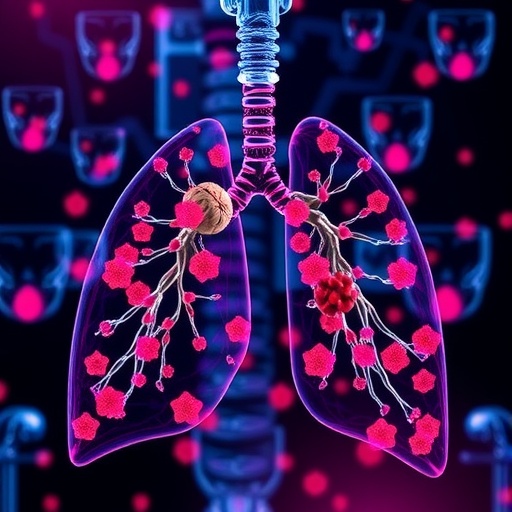In the ever-evolving landscape of biomedical research, a novel approach is emerging that transcends traditional strategies of manipulating genetic and biochemical pathways. Instead of solely focusing on modulating signaling molecules or altering gene expression, researchers from the University of Cincinnati have pioneered an innovative technique that involves the physical rearrangement of intracellular organelles to combat cancer. This groundbreaking work, led by Dr. Jiajie Diao and his team, introduces a paradigm shift by demonstrating that spatial reorganization within cells can significantly influence cellular metabolism, particularly under conditions designed to starve tumor cells of energy.
At the heart of this study lies lipid droplets—dynamic organelles best known as reservoirs of fatty acids within cells. These droplets act as crucial metabolic nodes that provide energy through their intimate interactions with mitochondria, the cell’s powerhouses. When cells undergo nutrient deprivation, lipid droplets migrate toward mitochondria, supplying them with fatty acids that are metabolized to sustain cellular energy demands. Dr. Diao eloquently likens lipid droplets to emergency fuel cans that rush to the location of an out-of-fuel car—mitochondria—thereby preventing energy collapse even under starvation conditions.
Cancer cells notoriously exploit this metabolic resilience to survive therapeutic starvation. When treatments aim to cut off nutrient supplies to tumors, cancer cells invoke lipid droplets as internal energy backups to evade death. Understanding this cellular safeguard mechanism became the impetus for Dr. Diao’s research: could physically preventing lipid droplets from reaching mitochondria intensify the starvation effect and thus suppress tumor growth more effectively?
To answer this, the researchers turned to optogenetics—a technique traditionally employed in neuroscience to manipulate cellular functions with light. By engineering a fusion of peptides, one targeting lipid droplets and the other activated by blue light, they created a light-responsive molecular “glue.” Upon blue light stimulation, these peptides aggregate lipid droplets into large clusters, effectively sequestering them away from mitochondria. This spatial confinement essentially strangles the cancer cells’ internal fuel supply, akin to locking all the city’s gasoline in one distant depot while the vehicles are stranded out of fuel.
This novel optogenetic approach was tested in both cancer cell lines and animal models, yielding compelling evidence of slowed tumor progression. The aggregation of lipid droplets resulted in a more complete metabolic starvation, depriving cancer cells of the necessary energy substrates required for their survival and proliferation. This physical blockade of energy transfer reveals an untapped vulnerability within cancer cell metabolism that had not been targeted by conventional therapies.
However, translating this technology directly to clinical applications poses challenges. The use of blue light as an activating stimulus is limited by its inability to penetrate human skin deeply enough to reach internal tumors. Acknowledging this barrier, Dr. Diao’s team is collaborating with chemists to develop pharmacological analogs of the optogenetic system. The goal is to conceive small-molecule drugs or injectable agents capable of mimicking the clustering and immobilization of lipid droplets without requiring external light activation, ultimately providing a practical therapeutic avenue.
The implications of this research extend beyond merely offering a new cancer treatment modality. It inaugurates a conceptual framework wherein the spatial organization of organelles themselves becomes a targetable factor in disease. By engineering the cellular architecture, scientists can modulate metabolic pathways, signaling dynamics, and hence cell fate decisions in unprecedented ways. This strategy of “subcellular physical distribution” resonates as a bold frontier in therapeutic design.
Beyond cancer, the manipulation of organelle positioning might influence a spectrum of metabolic and signaling disorders. Since organelles like lipid droplets and mitochondria are central to maintaining cellular homeostasis, their controlled rearrangement could potentially rectify dysfunctions in other diseases characterized by metabolic imbalance or aberrant signaling pathways.
This research also exemplifies the power of interdisciplinary collaboration, integrating molecular biology, biophysics, chemistry, and engineering. Such synergy allows for the creation of sophisticated tools like optogenetic peptides designed to achieve precise spatial control within live cells, a technical feat that was inconceivable in past decades. It underscores a shift toward “synthetic cell biology,” where reconfiguring intracellular topography is as crucial as modulating genetic or chemical circuits.
In summary, Dr. Diao and colleagues have unveiled a transformative approach that leverages the physics of cellular organization to augment cancer starvation therapies. By immobilizing lipid droplets through light-activated protein engineering, they have provided a proof of principle for targeting cancer metabolism at the organelle level. While clinical translation requires overcoming activation challenges, the ongoing development of drug-based mimetics offers hope for new, more effective cancer interventions.
Their findings, published as the cover story in the November 2025 issue of Trends in Biotechnology, herald a promising direction in cancer therapy that could extend to other diseases where altering organelle positioning modifies cellular fate. This novel modality of manipulating the physical landscape inside cells represents an exciting frontier, broadening the horizons of biomedical research and therapeutic innovation.
Subject of Research: Cells
Article Title: Optogenetic engineering of lipid droplet spatial organization for tumor suppression
News Publication Date: 1-Nov-2025
Web References: http://dx.doi.org/10.1016/j.tibtech.2025.06.002
Image Credits: Photo/Colleen Kelley/UC Marketing + Brand
Keywords: Cancer, Lipid droplets, Mitochondria, Optogenetics, Tumor suppression, Metabolism, Cellular starvation, Biomedical engineering
Tags: biomedical research advancements in oncologycancer cell architecture reorganizationDr. Jiajie Diao research findingsinnovative cancer treatment techniquesintracellular organelles in tumor biologylipid droplets and cancer metabolismmetabolic resilience in cancer therapymitochondrial interactions in cancer cellsnovel approaches to combat cancerspatial rearrangement of organellestumor energy starvation strategiesUniversity of Cincinnati cancer research





